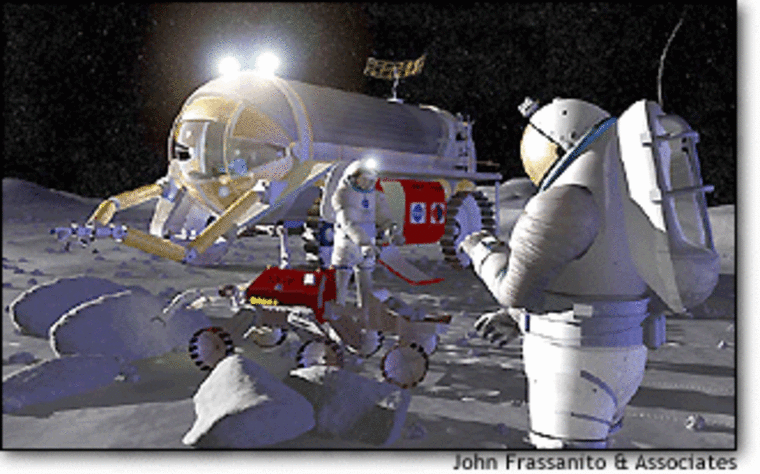The moon is a smorgasbord of useful resources that could be used to support a lunar base and even improve life on Earth, scientists say.
President Bush announced Wednesday that he wants to establish a base on the moon as a stepping stone toward further human exploration of the cosmos. With its weaker gravitational pull to tug on spacecraft, the moon makes a better jumping-off place than Earth, he said.
Bush noted Wednesday that lunar soil could be processed to make rocket fuel and create breathable air. But the list goes well beyond that, other scientists said after Bush’s speech.
“The bulk of the stuff we need to develop an industrial complex on the moon is all over the place,” said Alan Binder, director of the Lunar Research Institute in Tucson, Ariz., who advocates commercial exploitation of the moon. “We have a tremendous resource sitting out there.”
Basically, he said, “the moon is made of the same stuff we have here on Earth.”
Locked in the lunar terrain, he said, are versatile key elements. Oxygen can be used to make air for astronauts and rocket fuel, which combines liquid oxygen and hydrogen, he said. Silicon can be used to make solar cells to harvest solar energy there.
Iron could be used to build structures on the moon, Binder said. Aluminum, titanium and magnesium can be used in making spacecraft to go deeper into the cosmos, and making Earth-orbiting factories that can create alloys and crystals in zero gravity, he said.
What’s more, he said the lunar soil could be melted and poured into casts to make blocks for construction.
Scientists already have shown they can make water from lunar rocks by heating them, which causes their hydrogen to react with oxygen, said Gerald Kulcinski, director of the University of Wisconsin Fusion Technology Institute.
Carbon and nitrogen on the moon could be combined with other elements to enable growing food on the moon, he said.
Fusion power?
Eventually, Kulcinski said, the moon’s supply of a form of helium called helium-3 could be used in futuristic fusion reactors on Earth that would generate electricity without producing nuclear waste. Such fusion technology could also power rockets for deep space travel in the future, he said.
There’s so little helium-3 on Earth that the technology hasn’t been studied much, but the moon appears to have it in abundance, he said. That’s because the moon lacks the atmosphere and magnetic field that keep helium-3 from raining down on our planet from outer space.
The downside is that scientists haven't yet figured out how to build a safe, energy-producing fusion reactor. The ITER project, which draws its acronym from the old title "International Thermonuclear Experimental Reactor," is aimed at conducting fusion research, but scientists say commercial applications are decades away. Even then, it's not clear whether helium-3, mined on the moon and shipped back to Earth, will be the least expensive option for fueling such reactors.
Solar power?
One of the moon’s key resources is its dependable supply of solar energy, said David Criswell, director of the Institute of Space Systems Operations at the University of Houston and the University of Houston-Clear Lake.
It could not only supply lunar bases, but could also be harnessed as an energy source for Earth, he said. The idea would be to turn it into electricity and then microwaves that could be beamed to Earth.
Within a few decades, Criswell contends, such a stream of cheap energy could free people from depending on fossil and nuclear fuels and “enable everyone on Earth to be prosperous, and that’s impossible any other way.”
Not everyone has such a sunny view of beamed solar energy, however: Environmentalists worry about the effects of sending such concentrations of microwaves through Earth's atmosphere. If such a system is feasible, the energy beams could conceivably be used as weapons as well.
MSNBC's Alan Boyle contributed to this report.
